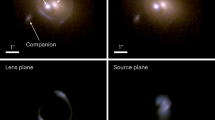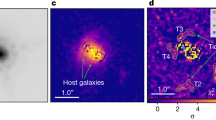Abstract
Gravitational lensing is a powerful tool for the study of the distribution of dark matter in the Universe. The cold-dark-matter model of the formation of large-scale structures (that is, clusters of galaxies and even larger assemblies) predicts1,2,3,4,5,6 the existence of quasars gravitationally lensed by concentrations of dark matter7 so massive that the quasar images would be split by over 7 arcsec. Numerous searches8,9,10,11 for large-separation lensed quasars have, however, been unsuccessful. All of the roughly 70 lensed quasars known12, including the first lensed quasar discovered13, have smaller separations that can be explained in terms of galaxy-scale concentrations of baryonic matter. Although gravitationally lensed galaxies14 with large separations are known, quasars are more useful cosmological probes because of the simplicity of the resulting lens systems. Here we report the discovery of a lensed quasar, SDSS J1004 + 4112, which has a maximum separation between the components of 14.62 arcsec. Such a large separation means that the lensing object must be dominated by dark matter. Our results are fully consistent with theoretical expectations3,4,5 based on the cold-dark-matter model.
This is a preview of subscription content, access via your institution
Access options
Subscribe to this journal
Receive 51 print issues and online access
$199.00 per year
only $3.90 per issue
Buy this article
- Purchase on Springer Link
- Instant access to full article PDF
Prices may be subject to local taxes which are calculated during checkout



Similar content being viewed by others
References
Narayan, R. & White, S. D. M. Gravitational lensing in a cold dark matter universe. Mon. Not. R. Astron. Soc. 231, 97–103 (1988)
Wambsganss, J., Cen, R., Ostriker, J. P. & Turner, E. L. Testing cosmogonic models with gravitational lensing. Science 268, 274–276 (1995)
Keeton, C. R. & Madau, P. Lensing constraints on the cores of massive dark matter halos. Astrophys. J. 549, L25–L28 (2001)
Wyithe, J. S. B., Turner, E. L. & Spergel, D. N. Gravitational lens statistics for generalized NFW profiles: Parameter degeneracy and implications for self-interacting cold dark matter. Astrophys. J. 555, 504–523 (2001)
Takahashi, R. & Chiba, T. Gravitational lens statistics and the density profile of dark halos. Astrophys. J. 563, 489–496 (2001)
Oguri, M. Constraints on the baryonic compression and implications for the fraction of dark halo lenses. Astrophys. J. 580, 2–11 (2002)
Navarro, J. F., Frenk, C. S. & White, S. D. M. A universal density profile from hierarchical clustering. Astrophys. J. 490, 493–508 (1997)
Maoz, D., Rix, H., Gal-Yam, A. & Gould, A. Survey for large-image separation lensed quasars. Astrophys. J. 486, 75–84 (1997)
Ofek, E. O., Maoz, D., Prada, F., Kolatt, T. & Rix, H. A survey for large-separation lensed FIRST quasars. Mon. Not. R. Astron. Soc. 324, 463–472 (2001)
Phillips, P. M. et al. The JVAS/CLASS search for 6-arcsec to 15-arcsec image separation lensing. Mon. Not. R. Astron. Soc. 328, 1001–1015 (2001)
Zhdanov, V. I. & Surdej, J. Quasar pairs with arcminute angular separations. Astron. Astrophys. 372, 1–7 (2001)
Kochanek, C. S. et al. CASTLES survey. 〈http://cfa-www.harvard.edu/castles/〉 (2003).
Walsh, D., Carswell, R. F. & Weymann, R. J. 0957 + 561 A, B — Twin quasistellar objects or gravitational lens? Nature 279, 381–384 (1979)
Colley, W. N., Tyson, J. A. & Turner, E. L. Unlensing multiple arcs in 0024 + 1654: Reconstruction of the source image. Astrophys. J. 461, L83–L86 (1996)
Turner, E. L., Ostriker, J. P. & Gott, J. R. III The statistics of gravitational lenses—the distributions of image angular separations and lens redshifts. Astrophys. J. 284, 1–22 (1984)
York, D. G. et al. The Sloan Digital Sky Survey: Technical summary. Astron. J. 120, 1579–1587 (2000)
Stoughton, C. et al. Sloan Digital Sky Survey: Early data release. Astron. J. 123, 485–548 (2002)
Gunn, J. E. et al. The Sloan Digital Sky Survey photometric camera. Astron. J. 116, 3040–3081 (1998)
Pier, J. R. et al. Astrometric calibration of the Sloan Digital Sky Survey. Astron. J. 125, 1559–1579 (2003)
Hogg, D. W., Finkbeiner, D. P., Schlegel, D. J. & Gunn, J. E. A photometricity and extinction monitor at the Apache Point Observatory. Astron. J. 122, 2129–2138 (2001)
Smith, J. A. et al. The u′g′r′i′z′ standard-star system. Astron. J. 123, 2121–2144 (2002)
Fukugita, M. et al. The Sloan Digital Sky Survey photometric system. Astron. J. 111, 1748–1756 (1996)
Blanton, M. R. et al. An efficient targeting strategy for multiobject spectrograph surveys: The Sloan Digital Sky Survey “tiling” algorithm. Astron. J. 125, 2276–2286 (2003)
Richards, G. T. et al. Spectroscopic target selection in the Sloan Digital Sky Survey: The quasar sample. Astron. J. 123, 2945–2975 (2002)
Oguri, M., Taruya, A., Suto, Y. & Turner, E. L. Strong gravitational lensing time delay statistics and the density profile of dark halos. Astrophys. J. 568, 488–499 (2002)
Kashikawa, N. et al. FOCAS: The Faint Object Camera and Spectrograph for the Subaru Telescope. Publ. Astron. Soc. Jpn 54, 819–832 (2002)
Cao, L., Wei, J.-Y. & Hu, J.-Y. High X-ray-to-optical flux ratio RASS-BSC sources. I. The optical identification. Astron. Astrophys. Suppl. 135, 243–253 (1999)
Keeton, C. R. Computational methods for gravitational lensing. Preprint at 〈http://xxx.lanl.gov/astro-ph/0102340〉 (2001).
Oke, J. B. et al. The Keck Low-Resolution Imaging Spectrometer. Publ. Astron. Soc. Pacif. 107, 375–385 (1995)
Miyazaki, S. et al. Subaru prime focus camera—Suprime-Cam. Publ. Astron. Soc. Jpn 54, 833–853 (2002)
Acknowledgements
Funding for the creation and distribution of the SDSS Archive has been provided by the Alfred P. Sloan Foundation, the Participating Institutions, the National Aeronautics and Space Administration, the National Science Foundation, the US Department of Energy, the Japanese Monbukagakusho, and the Max Planck Society. The SDSS website is http://www.sdss.org/. The SDSS is managed by the Astrophysical Research Consortium (ARC) for the Participating Institutions. The Participating Institutions are The University of Chicago, Fermilab, the Institute for Advanced Study, The Japan Participation Group, The Johns Hopkins University, Los Alamos National Laboratory, the Max-Planck-Institute for Astronomy (MPIA), the Max-Planck-Institute for Astrophysics (MPA), New Mexico State University, University of Pittsburgh, Princeton University, the United States Naval Observatory, and the University of Washington. This Letter is based in part on data collected at the Subaru telescope, which is operated by the National Astronomical Observatory of Japan, W. M. Keck Observatory, which is operated as a scientific partnership among the California Institute of Technology, the University of California, and the National Aeronautics and Space Administration, and the Apache Point Observatory (APO) 3.5-m telescope, which is owned and operated by the Astrophysical Research Consortium. Part of this work was performed under the auspices of the U.S. Department of Energy at the University of California Lawrence Livermore National Laboratory.
Author information
Authors and Affiliations
Corresponding author
Ethics declarations
Competing interests
The authors declare that they have no competing financial interests.
Rights and permissions
About this article
Cite this article
Inada, N., Oguri, M., Pindor, B. et al. A gravitationally lensed quasar with quadruple images separated by 14.62 arcseconds. Nature 426, 810–812 (2003). https://doi.org/10.1038/nature02153
Received:
Accepted:
Issue Date:
DOI: https://doi.org/10.1038/nature02153
This article is cited by
-
Unveiling the Universe with emerging cosmological probes
Living Reviews in Relativity (2022)
-
A CMB Millikan experiment with cosmic axiverse strings
Journal of High Energy Physics (2020)
-
Shadows and strong gravitational lensing: a brief review
General Relativity and Gravitation (2018)
-
Arc Statistics
Space Science Reviews (2013)
-
Time delay in the Einstein-Straus solution
General Relativity and Gravitation (2011)
Comments
By submitting a comment you agree to abide by our Terms and Community Guidelines. If you find something abusive or that does not comply with our terms or guidelines please flag it as inappropriate.



